NEC FP1350, FP950 User Manual
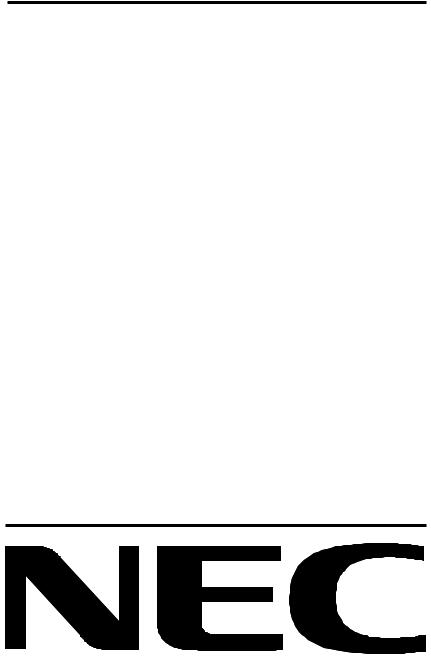
MultiSync FP950
MultiSync FP1350
User's Manual
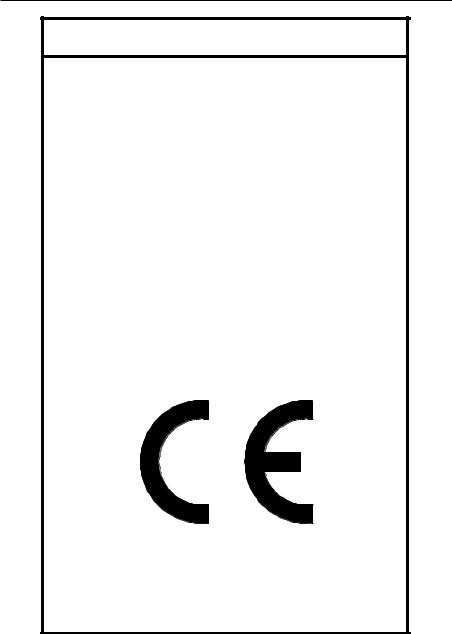
Declaration
Declaration of the Manufacturer
We hereby certify that the color monitors
MultiSync FP950 JC-1946UMW
MultiSync FP1350 JC-2241UMW
are in compliance with
Council Directive 73/23/EEC: - EN 60950
Council Directive 89/336/EEC:
-EN 55022
-EN 61000-3-2
-EN 61000-3-3
-EN 50082-1 (IEC 801-2) (IEC 801-3) (IEC 801-4)
and marked with
NEC Home Electronics, Ltd. 686-1, NISHIOI OI-MACHI ASHIGARAKAMI-GUN KANAGAWA 258-8533, JAPAN

Safety Instruction
Caution:
When operating the JC-1946UMW/JC-2241UMW with a 220-240V AC power source in Europe except UK, use the power cord provided with the monitor.
In UK, a BS approved power cord with moulded plug has a Black (five Amps) fuse installed for use with this equipment. If a power cord is not supplied with this equipment please contact your supplier.
When operating the JC-1946UMW/JC-2241UMW with a 220-240V AC power source in Australia, use the power cord provided with the monitor.
For all other cases, use a power cord that matches the AC voltage of the power outlet and has been approved by and complies with the safety standard of your particular country.
ENERGY STAR® Product
As an ENERGY STAR Partner, NEC Technologies has determined that this product meets the ENERGY STAR guidelines for energy efficiency. The ENERGY STAR emblem does not represent EPA endorsement of any product or service.
IBM is registered trademark of International Business Machines Corporation. Apple and Macintosh are registered trademarks of Apple Computer Inc. Microsoft and Windows are registered trademarks of the Microsoft Corporation. ENERGY STAR is a U.S. registered trademark.
NEC is a registered trademark of NEC Corporation.
ErgoDesign is a registered trademarks of NEC Home Electronics, Ltd. in U.K., Germany, France, Spain, Italy, Denmark, Norway, Sweden and Benelux.
IPM, OSM, ColorControl, OptiClear, GlobalSync, EdgeLock and Advanced Digital Control System are trademarks of NEC Home Electronics, Ltd.
MultiSync is a registered trademark of NEC Technologies, Inc in U.S. and of NEC Home Electronics, Ltd in Canada, U.K., Germany, France, Spain, Italy, Austria, Benelux, Switzerland, Denmark, Finland, Norway and Saudi Arabia.
All other trademarks or registered trademarks are property of their respective owners.

TCO’99
Congratulations!
You have just purchased a TCO'99 approved and labelled product! Your choice has provided you with a product developed for professional use. Your purchase has also contributed to reducing the burden on the environment and also to the further development of environmentally adapted electronics products.
Why do we have environmentally labelled computers?
In many countries, environmental labelling has become an established method for encouraging the adaptation of goods and services to the environment. The main problem, as far as computers and other electronics equipment are concerned, is that environmentally harmful substances are used both in the products and during their manufacture. Since it is not so far possible to satisfactorily recycle the majority of electronics equipment, most of these potentially damaging substances sooner or later enter nature.
There are also other characteristics of a computer, such as energy consumption levels, that are important from the viewpoints of both the work (internal) and natural (external) environments. Since all methods of electricity generation have a negative effect on the environment (e.g. acidic and climate-influencing emissions, radioactive waste), it is vital to save energy. Electronics equipment in offices is often left running continuously and thereby consumes a lot of energy.
What does labelling involve?
This product meets the requirements for the TCO'99 scheme which provides for international and environmental labelling of personal computers. The labelling scheme was developed as a joint effort by the TCO (The Swedish Confederation of Professional Employees), Svenska Naturskyddsforeningen (The Swedish Society for Nature Conservation) and Statens Energimyndighet (The Swedish National Energy Administration).
Approval requirements cover a wide range of issues: environment, ergonomics, usability, emission of electric and magnetic fields, energy consumption and electrical and fire safety.

The environmental demands impose restrictions on the presence and use of heavy metals, brominated and chlorinated flame retardants, CFCs (freons) and chlorinated solvents, among other things. The product must be prepared for recycling and the manufacturer is obliged to have an environmental policy which must be adhered to in each country where the company implements its operational policy.
The energy requirements include a demand that the computer and/or display, after a certain period of inactivity, shall reduce its power consumption to a lower level in one or more stages. The length of time to reactivate the computer shall be reasonable for the user.
Labelled products must meet strict environmental demands, for example, in respect of the reduction of electric and magnetic fields, physical and visual ergonomics and good usability.
Below you will find a brief summary of the environmental requirements met by this product. The complete environmental criteria document may be ordered from:
TCO Development
SE-114 94 Stockholm, Sweden
Fax: +46 8 782 92 07
Email (Internet): development@tco.se
Current information regarding TCO'99 approved and labelled products may also be obtained via the Internet, using the address: http://www.tco-info.com/
Environmental requirements
Flame retardants
Flame retardants are present in printed circuit boards, cables, wires, casings and housings. Their purpose is to prevent, or at least to delay the spread of fire. Up to 30% of the plastic in a computer casing can consist of flame retardant substances. Most flame retardants contain bromine or chloride, and those flame retardants are chemically related to another group of environmental toxins, PCBs. Both the flame retardants containing bromine or chloride and the PCBs are suspected of giving rise to severe health effects, including reproductive damage in fish-eating birds and mammals, due to the bio-accumulative* processes. Flame retardants have been found in human blood and researchers fear that disturbances in foetus development may occur.

The relevant TCO'99 demand requires that plastic components weighing more than 25 grams must not contain flame retardants with organically bound bromine or chlorine. Flame retardants are allowed in the printed circuit boards since no substitutes are available.
Cadmium**
Cadmium is present in rechargeable batteries and in the colour-generating layers of certain computer displays. Cadmium damages the nervous system and is toxic in high doses. The relevant TCO'99 requirement states that batteries, the colour-generating layers of display screens and the electrical or electronics components must not contain any cadmium.
Mercury**
Mercury is sometimes found in batteries, relays and switches. It damages the nervous system and is toxic in high doses. The relevant TCO'99 requirement states that batteries may not contain any mercury. It also demands that mercury is not present in any of the electrical or electronics components associated with the labelled unit.
CFCs (freons)
The relevant TCO'99 requirement states that neither CFCs nor HCFCs may be used during the manufacture and assembly of the product. CFCs (freons) are sometimes used for washing printed circuit boards. CFCs break down ozone and thereby damage the ozone layer in the stratosphere, causing increased reception on earth of ultraviolet light with e.g. increased risks of skin cancer (malignant melanoma) as a consequence.
Lead**
Lead can be found in picture tubes, display screens, solders and capacitors. Lead damages the nervous system and in higher doses, causes lead poisoning. The relevant TCO´99 requirement permits the inclusion of lead since no replacement has yet been developed.
*Bio-accumulative is defined as substances which accumulate within living organisms
**Lead, Cadmium and Mercury are heavy metals which are
Bio-accumulative.
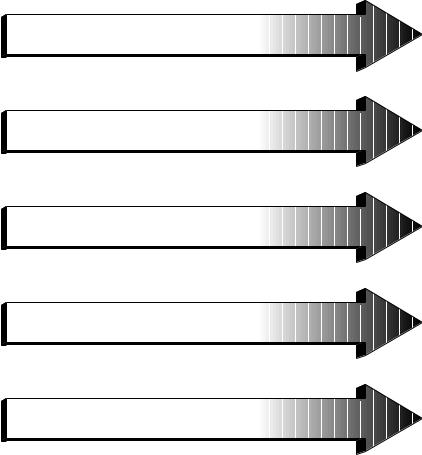
English
Deutsch
Français
Español
Italiano

English
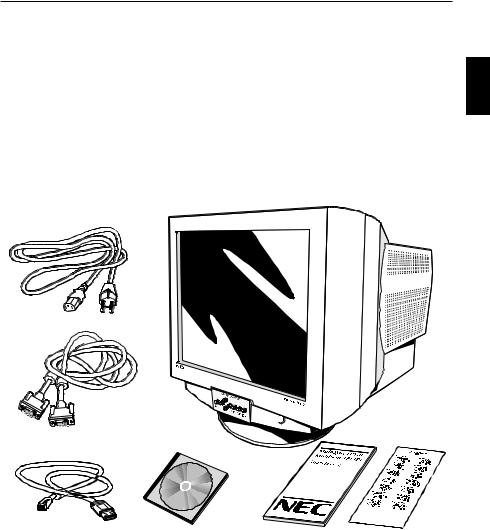
Contents
FP Series monitor box* should contain the following:
•MultiSync FP Series Monitor with tilt/swivel base MultiSync FP950 (JC-1946UMW) or
MultiSync FP1350 (JC-2241UMW)
•Power Cord
•Signal Cable
•USB Cable
•Monitor Control Software
•User’s Manual
•Sales Office List
Power Cord
Signal Cable



USB Cable |
Monitor |
User's Manual |
Sales Office List |
|
Control Software |
*Remember to save your original box and packing material to transport or ship the monitor.
E - 1

Quick Start
To attach the MultiSync FP Series monitor to your system, follow these instructions:
1.Turn off the power to your computer and MultiSync monitor. If you are using the signal cable, continue to Step 2.
If you are using a BNC cable, please skip to Step 3.
NOTE: BNC cables may be purchased at your local electronics store.
2.For the PC: Connect one end of the 15-pin mini D-SUB signal cable to the connector of the display card in your system (Figure A.1) and the other end to the back of the monitor (Figure A.2). Tighten all screws. Proceed to Step 4.
For the Mac: Connect the Macintosh cable adapter (not included) to the computer (Figure B.1). Attach one end of the 15-pin mini D-SUB signal cable to the Macintosh cable adapter (not included) (Figure B.1) and the other end to the back of the monitor (Figure B.2). Tighten all screws. Proceed to Step 4.
3.Connect the BNC cable to the appropriate connectors on the back of the monitor. Connect the red BNC cable to the BNC connector on the monitor labeled R, the green BNC cable to the BNC connector on the monitor labeled G(/Sync), the blue BNC cable to the BNC connector on the monitor labeled B. If you have a fourth BNC connector (Composite Sync), connect it to the BNC connector on the monitor labeled HS/CS. If you have a fifth BNC connector (Vertical Sync), connect it to the BNC connector on the monitor labeled VS (Figure C.1).
Note: Incorrect cable connections may result in irregular operation or damage display components.
E - 2

Computer |
Computer |
15-pin mini |
|
D-SUB |
Mac Adapter |
|
|
|
(not included) |
Signal Cable |
Signal Cable |
Figure A.1 |
Figure B.1 |
4.Connect one end of the power cord to the MultiSync FP Series monitor and the other end to the power outlet (Figure D.1).
5.Turn on the monitor (Figure E.1) and the computer.
6.The Factory Setting for your monitor is set for D-SUB installation. If you are using a BNC cable connection, push the BNC/D-SUB button on the front of the monitor (Figure E.1) to switch settings.
NOTE: If you have any problems, please refer to the Troubleshooting section of this User's Manual.
Signal
Cable
Signal Cable |
Mac Adapter |
(not included) |
|
Figure A.2 |
Figure B.2 |
E - 3
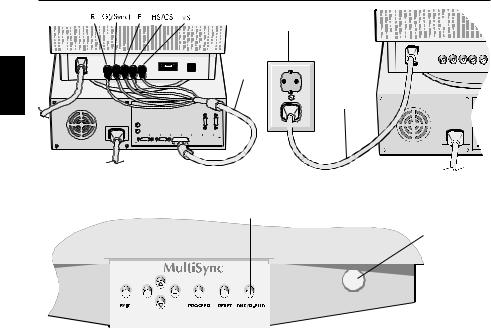
Power Outlet |
BNC |
Con- |
nector |
Power
Cord
|
|
|
|
|
|
|
|
|
|
|
|
|
|
|
|
|
|
|
|
|
|
|
|
|
|
|
|
|
|
|
|
|
|
|
|
|
|
|
|
|
|
|
|
|
|
|
|
|
|
|
|
|
|
|
|
|
|
|
|
|
|
|
|
|
|
|
|
|
|
|
|
|
|
|
Figure C.1 |
Figure D.1 |
|||||||||||||
|
|
|
|
|
|
|
|
|
|
|
|
|
|
BNC/D-SUB |
Power Button
Figure E.1
E - 4

If your computer is equipped with USB and uses the Windows ® 98 operating system and you want to operate the monitor’s user controls using your system, you can install USB support by using the following procedure. To attach the USB port on your MultiSync FP Series monitor to a USB port on your system:
1.Using the supplied USB cable, connect the USB Series B connector end to the USB upstream port on the monitor (Figure 1).
2.Connect the other end of the supplied cable to the USB downstream port on the computer (or to a USB Hub attached to the computer) (Figure 1).
3.Install the supplied Monitor Control Software.
USB upstream port
USB series B connector end
USB downstream port
Figure 1
E - 5

Controls
OSM(On-Screen Manager) control buttons on the front of the monitor function as follows:
EXIT
CONTROL
▲/▼
CONTROL -/+
PROCEED
RESET
Main Menu
Exits the OSM menu.
Moves the highlighted area up/down to select one of the controls.
Moves highlighted area left/right to select one of the controls.
Has no function .
Resets all the controls within the highlighted menu to the factory setting.
Sub-Menu
Exits to the OSM main menu.
Moves the highlighted area up/down to select one of the controls.
Moves the bar in the - or + direction to decrease or increase the adjustment.
Only executes control or enters sub, sub-menu.
Resets the highlighted control to the factory setting.
NOTE: When RESET is pressed in the main and sub-menu, a warning window will appear allowing you to cancel the reset function.
When OSM controls are activated, icons are displayed at the top of the menu. If an arrow (→) is displayed in a sub-menu, it indicates further choices are available. To enter a sub, sub-menu, press PROCEED.
ab Brightness/Contrast Controls
BRIGHTNESS: Adjusts the overall image and background screen brightness.
CONTRAST: Adjusts the image brightness in relation to the background.
DEGAUSS: Eliminates the build-up of stray magnetic fields which alter the correct scan of the electron beams and affect the purity of the screen colours, focus, and convergence. When activated, your screen image will jump and waver a bit as the screen is demagnetized.
Caution: Please allow a minimum of 20 minutes to elapse between uses of the Degauss function.
de Size and Position Controls
AUTO ADJUST: Automatically adjusts the horizontal and vertical size and position settings for applicable signal timings.
LEFT/RIGHT: Moves the image horizontally (left or right).
DOWN/UP: Moves the image vertically (up or down).
NARROW/WIDE: Decreases or increases the horizontal size of the image.
SHORT/TALL: Decreases or increases the vertical size of the image.
E - 6

xColor Control
Color Presets 1 through 5, selects the desired color setting. The bar is replaced by the color setting choice from 1 to 5. Each color setting is adjusted at the factory to the stated Kelvin. If a setting is adjusted, the name of the setting will change from Kelvin to Custom.
RED, GREEN, BLUE: Decreases or increases red, green, or blue depending upon which is selected. The change in color will appear on screen and the direction (decrease or increase) will be shown by the bars.
pq Geometry Controls
The Geometry controls allow you to adjust the curvature or angle of the sides of your display.
IN/OUT (pincushion): Decreases or increases the curvature of the sides either inward or outward.
LEFT/RIGHT (pincushion balance): Decreases or increases the curvature of the sides either to the left or right.
TILT (parallelogram): Decreases or increases the tilt of the sides either to the left or right.
ALIGN (trapezoidal): Decreases or increases the bottom of the screen to be the same as the top.
ROTATE (raster rotation): Rotates the entire display clockwise or counter clockwise.
? Tools 1
MOIRÉ CANCELER: Moiré is a wavy pattern which can sometimes appear on the screen. The pattern is repetitive and superimposed as rippled images. When running certain applications, the wavy pattern is more evident than in others. To reduce moiré, adjust the ON/Level by using the –/+ CONTROL buttons.
BASIC CONVERGENCE: Aligns all three colors (R, G, B) to form a single color (white). The purpose of this control is to ensure that a white line drawn on the screen is as crisp and clear as possible.
•Use the Horizontal control to adjust the alignment of the white lines in the up/down direction.
•Use the Vertical control to adjust the alignment of the white lines in the left/right direction.
E - 7

AREA CONVERGENCE: A small window will appear to indicate the area of adjustment — Top Horizontal, Top Vertical, Bottom Horizontal or Bottom Vertical.
CORNER CORRECTION: Allows you to adjust the geometry of the corners of your display — Top, Top Balance, Bottom or Bottom Balance.
LINEARITY: The Linearity selection allows you to adjust the spacing of the areas on the screen. The purpose of this control is to ensure that a 2 cm circle is a true 2 cm circle wherever it is drawn on the screen. The best way to determine the vertical linearity is as follows:
•Draw equally spaced horizontal lines using a drawing application that has a ruler.
•Use the Vertical Balance control to adjust the lines near the top and bottom of your screen.
•Use the Vertical control to adjust the spacing between the lines near the centre and top of your screen.
GLOBALSYNC CONTROL: Eliminates picture impurities that may result from the earth’s magnetic field. While in the sub-menus (GLOBALSYNC, TOP LEFT, TOP RIGHT, BOTTOM LEFT or BOTTOM RIGHT), use the –/+ control buttons to fine tune the GlobalSync corrections.
Note: |
NEC recommends that you perform GlobalSync correction while |
|
running a typical application such as a spreadsheet or text |
|
document. |
SHARPNESS: Allows you to adjust the clarity of the image, based on the quality of the signal received from the computer.
•Use a full text document to make this adjustment.
•Cycle through the four sharpness settings and select the one that provides the sharpest focus and contrast of the text.
FACTORY PRESET: Selecting Factory Preset allows you to reset most OSM settings back to the factory settings. A warning statement will appear to confirm that you do want to reset ALL settings. Individual settings can be reset by highlighting the control to be reset and pressing the RESET button.
? Tools 2
LANGUAGE: OSM menus are available in 7 languages.
OSM POSITION: You can choose where you would like the OSM controls menu to appear on your screen. Selecting OSM Position allows you to manually adjust the OSM controls menu left, right, up or down.
E - 8

OSM TURN OFF: The OSM menu will stay on as long as it is in use. In the OSM Turn Off sub-menu, you can select how long the monitor waits after the last touch of a button to shut off the OSM menu. The preset choices are 10, 20, 30, 60, 120 seconds.
OSM LOCK OUT: This control completely locks out access to all OSM functions except brightness and contrast controls. When attempting to activate OSM while in the lockout mode, a screen will appear indicating that OSM controls are locked out. To activate the OSM Lockout function, press PROCEED, then press “▲” and hold down simultaneously. To de-activate the OSM Lockout, press PROCEED, then press “▲” and hold down simultaneously.
IPM System Off Mode:
ENABLE: |
The IPM works normally, all stages |
|
of the energy saving are used. |
DISABLE: |
The OFF MODE of the IPM is not |
|
used. |
NOTE: For standard computers and display cards you should keep the factory setting ENABLE.
EDGELOCK CONTROL: Operating your monitor at a non-standard timing may cause images to appear darker than normal or have color distortion. Use of the EdgeLock control will adjust images to their normal state.
REFRESH NOTIFIER: A message will advise you if the refresh rate of the signal being applied to the monitor by the computer is too low. For further information, please refer to your display card or system manual. Factory setting is OFF.
z Information
Provides you with additional information which includes the following:
DISPLAY MODE: Indicates the current mode and frequency setting of the monitor.
FITNESS TIPS: The Fitness Tips provide you with helpful reminders to periodically rest your eyes. You may select how frequently the reminders are displayed based upon your individual needs. Select an interval from 15, 30, 45, 60, 90 or 120 minutes for the tips to appear. When the tips appear, follow the advice of the tips and press EXIT to clear.
MONITOR INFO: Indicates the model number and the serial number.
E - 9

Recommended use
Safety Precautions and Maintenance
FOR OPTIMUM PERFORMANCE, PLEASE NOTE THE
FOLLOWING WHEN SETTING UP AND USING
THE MULTISYNC FP SERIES COLOR MONITOR:
•DO NOT OPEN THE MONITOR. There are no user serviceable parts inside and opening or removing covers may expose you to dangerous shock hazards or other risks. Refer all servicing to qualified service personnel.
•Use the monitor in a clean, dry area.
•Do not spill any liquids into the cabinet or use your monitor near water.
•Do not insert objects of any kind into the cabinet slots, as they may touch dangerous voltage points, which can be harmful or fatal or may cause electric shock, fire or equipment failure.
•Do not place any heavy objects on the power cord. Damage to the cord may cause shock or fire.
•Do not place this product on a sloping or unstable cart, stand or table, as the monitor may fall, causing serious damage to the monitor.
•Keep the monitor away from high capacity transformers, electric motors and other devices such as external speakers or fans, which may create strong magnetic fields.
•If possible, position the monitor so that it is facing the east to minimize the effects of the earth’s magnetic field.
•Changing the direction of the monitor while it is powered on may cause image discoloration. To correct this, turn the monitor off for 20 minutes before powering it back on.
•To separate the equipment from the power source you have to remove the plug from the inlet socket.
•The power supply cord you use must have been approved by and comply with the safety standards of your country. (Type H05VV-F should be used except in UK)
•In UK, use a BS-approved power cord with molded plug having a black (5A) fuse installed for use with this monitor. If a power cord is not supplied with this monitor, please contact your supplier.
Immediately unplug your monitor from the wall outlet and refer servicing to qualified service personnel under the following conditions:
•When the power supply cord or plug is damaged.
•If liquid has been spilled, or objects have fallen into the monitor.
•If the monitor has been exposed to rain or water.
E - 10
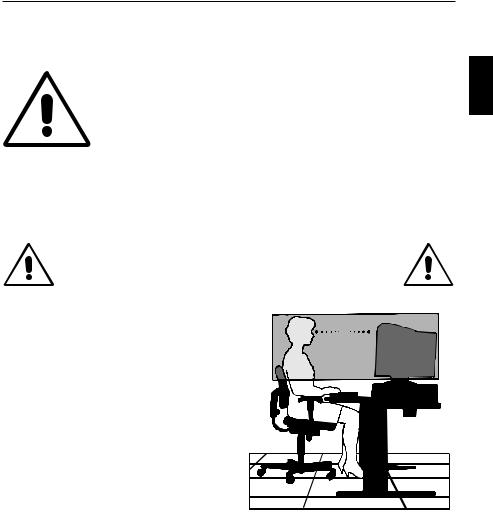
•If the monitor has been dropped or the cabinet damaged.
•If the monitor does not operate normally by following operating instructions.
•Allow adequate ventilation around the monitor so that heat can properly dissipate. Do not block ventilated openings or place the monitor near a radiator or other heat sources. Do not put anything on top of monitor.
• The power cable connector is the primary means of detaching the system from the power supply. The
CAUTION |
monitor should be installed close to a power outlet |
|
which is easily accessible. |
||
|
||
|
• Handle with care when transporting. Save packaging |
|
|
for transporting. |
CORRECT PLACEMENT AND ADJUSTMENT OF THE
MONITOR CAN REDUCE EYE, SHOULDER AND NECK
FATIGUE. CHECK THE FOLLOWING WHEN YOU
POSITION THE MONITOR:
• Adjust the monitor height so that the
top of the screen is at or slightly below eye level. Your eyes should
look slightly downward when
viewing the middle of the screen.
• Position your monitor no closer than 40 cm and no further away than 70 cm from your eyes. The optimal
distance is 60 cm.
• Rest your eyes periodically by focusing on an object at least 6 m
away. Blink often.
• Position the monitor at a 90° angle
to windows and other light sources to minimize glare and reflections. Adjust the monitor tilt so that ceiling lights do not reflect on your screen.
•If reflected light makes it hard for you to see your screen, use an anti-glare filter.
•Clean your monitor regularly. Use a lint-free, non-abrasive cloth and a non-alcohol, neutral, non-abrasive cleaning solution or glass cleaner to minimize dust.
•Adjust the monitor’s brightness and contrast controls to enhance readability.
E - 11

•Use a document holder placed close to the screen.
•Position whatever you are looking at most of the time (the screen or reference material) directly in front of you to minimize turning your head while you are typing.
•Get regular eye checkups.
Ergonomics
To realize the maximum ergonomics benefits, we recommend the following:
•Adjust the Brightness until the background raster disappears
•Do not position the Contrast controls to its maximum setting
•Use the preset Size and Position controls with standard signals
•Use the preset Color Setting and Sides Left/Right controls
•Use non-interlaced signals with a vertical refresh rate between 75-160 Hz
•Do not use primary color blue on a dark background, as it is difficult to see and may produce eye fatigue due to insufficient contrast
E - 12

Specifications
Monitor |
|
MultiSync FP950 |
Notes |
|
|
|
Specifications |
Monitor |
|
|
|
||
|
|
|
|
|
|
|
Picture Tube |
|
Diagonal: |
49.5 cm (19 inch) |
90° deflection, 0.25-0.27 mm (variable) grille pitch, |
|
|
|
|
Viewable Image Size: |
45.8 cm (18 inch) |
medium short persistence phosphor, aperture grille |
|
|
|
|
Radius: |
57800 mm |
CRT, multi-layered, anti-static screen coating, |
|
|
|
|
|
|
semi-dark tint screen, and OptiClear screen surface. |
|
|
Input Signal |
|
Video: |
ANALOG 0.7 Vp-p/75 Ω |
|
|
|
|
|
|
|
|||
|
|
Sync: |
Separate sync. TTL Level |
|
|
|
|
|
|
Horizontal sync. Positive/Negative |
|
|
|
|
|
|
Vertical sync. Positive/Negative |
|
|
|
|
|
|
Composite sync. (Positive/Negative) (TTL Level) |
|
|
|
|
|
|
Sync on Green video (Positive) 0.7 Vp-p and sync. |
|
|
|
|
|
|
(Negative) 0.3 Vp-p |
|
|
|
Display Colors |
|
Analog input: |
Unlimited number of Colors |
Depends on the display card |
|
|
Synchronization |
|
Horizontal: |
31 kHz to 110 kHz |
Automatically |
|
|
Range |
|
Vertical: |
55 Hz to 160 Hz |
Automatically |
|
|
Resolutions Supported |
|
640 x 480 @ 60 to 160 Hz |
Some systems may not support all modes listed |
|
|
|
Resolution based on horizontal and vertical |
800 x 600 @ 55 to 160 Hz |
|
|
|
||
frequencies only |
|
832 x 624 @ 55 to 160 Hz |
|
|
|
|
|
|
|
1024 x 768 @ 55 to 136 Hz |
|
|
|
|
|
|
1152 x 870 @ 55 to 120 Hz |
|
|
|
|
|
|
1280 x 1024 @ 55 to 102 Hz . . . . . . . . . . . . . . . . . . |
NEC cites recommended resolution at 85 Hz for |
|
|
|
|
|
1600 x 1200 @ 55 to 88 Hz |
optimal display performance. |
|
|
|
|
|
1792 x 1344 @ 55 to 78 Hz |
|
|
|
|
|
|
1800 x 1440 @ 55 to 73 Hz |
|
|
|
|
|
|
1856 x 1392 @ 55 to 75 Hz |
|
|
|
|
|
|
1920 x 1440 @ 55 to 73 Hz |
|
|
|
Active Display Area |
|
Horizontal: |
356 mm |
Dependent upon signal timing used, and does not |
|
|
(Factory setting) |
|
Vertical: |
267 mm |
include border area. |
|
|
Active Display Area |
|
|
366 mm |
Dependent upon signal timing used, and does not |
|
|
(Full scan) |
|
|
275 mm |
include border area. |
|
|
Power Supply |
|
|
AC 100-120 V / 220-240 V, 50/60 Hz |
|
|
|
Current Rating |
|
|
1.8 A @ 100-120 V / 0.8 A @ 220-240 V |
|
|
|
Dimensions |
|
|
442 (W) x 456 (H) x 447 (D) mm |
|
|
|
Weight |
|
|
27.5 kg |
|
|
|
|
|
|
|
|
|
|
Enviromental Considerations
Operating Temperature: +10° C to +35° C
Humidity: 30% to 80%
Altitude: 0 to 3000 m
Storrage Temperature: -20° C to +60° C
Humidity: 10% to 90%
Altitude: 0 to 13700 m
NOTE: Technical specifications are subject to change without notice.
E - 13

|
|
Monitor |
|
MultiSync FP1350 |
Notes |
|
|
|
Specifications |
Monitor |
|
||
|
|
|
|
|
|
|
|
|
Picture Tube |
|
Diagonal: |
55.3 cm (22 inch) |
90° deflection, 0.25-0.27 mm (variable) grille pitch, |
|
|
|
|
Viewable Image Size: |
50.8 cm (20 inch) |
medium short persistence phosphor, aperture grille |
|
|
|
|
Radius: |
57800 mm |
CRT, multi-layered, anti-static screen coating, |
|
|
|
|
|
|
semi-dark tint screen, and OptiClear screen surface. |
|
|
Input Signal |
|
Video: |
ANALOG 0.7 Vp-p/75 Ω |
|
|
|
|
|
|||
|
|
|
|
Sync: |
Separate sync. TTL Level |
|
|
|
|
|
|
Horizontal sync. Positive/Negative |
|
|
|
|
|
|
Vertical sync. Positive/Negative |
|
|
|
|
|
|
Composite sync. (Positive/Negative) (TTL Level) |
|
|
|
|
|
|
Sync on Green video (Positive) 0.7 Vp-p and sync. |
|
|
|
|
|
|
(Negative) 0.3 Vp-p |
|
|
|
Display Colors |
|
Analog input: |
Unlimited number of Colors |
Depends on the display card |
|
|
Synchronization |
|
Horizontal: |
31 kHz to 115 kHz |
Automatically |
|
|
Range |
|
Vertical: |
55 Hz to 160 Hz |
Automatically |
|
|
Resolutions Supported |
|
640 x 480 @ 60 to 160 Hz |
Some systems may not support all modes listed |
|
|
|
Resolution based on horizontal and vertical |
800 x 600 @ 55 to 160 Hz |
|
||
|
|
frequencies only |
|
832 x 624 @ 55 to 160 Hz |
|
|
|
|
|
|
|
1024 x 768 @ 55 to 143 Hz |
|
|
|
|
|
|
1152 x 870 @ 55 to 125 Hz |
|
|
|
|
|
|
1280 x 1024 @ 55 to 107 Hz |
|
|
|
|
|
|
1600 x 1200 @ 55 to 92 Hz . . . . . . . . . . . . . . . . . . |
NEC cites recommended resolution at 85 Hz for |
|
|
|
|
|
1792 x 1344 @ 55 to 81 Hz |
optimal display performance. |
|
|
|
|
|
1800 x 1440 @ 55 to 76 Hz |
|
|
|
|
|
|
1856 x 1392 @ 55 to 78 Hz |
|
|
|
|
|
|
1920 x 1440 @ 55 to 76 Hz |
|
|
|
Active Display Area |
|
Horizontal: |
396 mm |
Dependent upon signal timing used, and does not |
|
|
(Factory setting) |
|
Vertical: |
297 mm |
include border area. |
|
|
Active Display Area |
|
|
406 mm |
Dependent upon signal timing used, and does not |
|
|
(Full scan) |
|
|
305 mm |
include border area. |
|
|
Power Supply |
|
|
AC 100-120 V / 220-240 V, 50/60 Hz |
|
|
|
Current Rating |
|
|
2.3 A @ 100-120 V / 1.0 A @ 220-240 V |
|
|
|
Dimensions |
|
|
483 (W) x 501 (H) x 472 (D) mm |
|
|
|
Weight |
|
|
34.0 kg |
|
|
|
|
|
|
|
|
Enviromental Considerations
Operating Temperature: +10° C to +35° C
Humidity: 30% to 80%
Altitude: 0 to 3000 m
Storrage Temperature: -20° C to +60° C
Humidity: 10% to 90%
Altitude: 0 to 13700 m
NOTE: Technical specifications are subject to change without notice.
E - 14

Features
Flat Aperture Grille CRT: Delivers an unparalleled viewing experience with a virtually flat image, eliminating distortion and reducing glare so that what you see on-screen is what you get on your printed output. The striped phosphor alignment of the CRT delivers superior vertical definition with improved brightness for more uniform image contrast.
OptiClear Screen Surface: Reduces reflection and glare and increases contrast without sacrificing focus level, clarity or brightness.
Dual Dynamic Beam Focus: Provides precise, continuous focus adjustment of the electron beams and optimum image quality, even to the far edge of the screen.
Color Control System: Allows you to change between five color settings on your display to match your personal preference.
OSM (On-Screen Manager) Controls: Allow you to quickly and easily adjust all elements of your screen image via simple to use on-screen menus.
ErgoDesign Features: Enhance human ergonomics to improve the working environment, protect the health of the user and save money and is compliant with TCO'99 and MPRII for lower emissions.
Plug and Play: The Microsoft® solution with the Windows® 95/98 operating system facilitates setup and installation by allowing the monitor to send its capabilities (such as screen size and resolutions supported) directly to your computer, automatically optimizing display performance.
IPM (Intelligent Power Manager) System: Provides innovative power-saving methods that allow the monitor to shift to a lower power consumption level when on but not in use, saving your monitor energy costs, reducing emissions and lowering the air conditioning costs of the workplace and is compliant with NUTEK, VESA DPMS and EPA ENERGY STAR.
Mode |
LED Indicator |
Power Saving |
On |
Green |
None |
|
|
|
Stand By |
Green |
Minimum (Quickest Recovery) |
|
|
|
Suspend |
Yellow |
Moderate (< 15 Watts, Moderate Recovery) |
|
|
|
Off (IPM Mode) |
Orange |
Maximum (< 5 Watts, Slow Recovery) |
|
|
|
Off (Power |
No Light |
No Power Used (Fully Off) |
Switch, Off) |
|
|
Reduced Magnetic Field Technology: Reduces magnetic and alternating electric field emissions and static electricity, addressing ergonomic concerns regarding potential risks from extended computer monitor use and is compliant with TCO'99 and MPRII.
E - 15

Multiple Frequency Technology: Automatically adjusts monitor to the display card’s scanning frequency, thus displaying the resolution required.
FullScan Capability: Allows you to use the entire screen area in most resolutions, significantly expanding image size.
GlobalSync/Corner Purity Control: NEC’s unique design automatically eliminates picture impurities that may result from stray magnetic fields (including the earth’s permanent magnets, etc.) and now allows you to easily adjust impurities in the four corners of your monitor.
Auto Adjust: Allows you to easily and quickly adjust the suitable horizontal and vertical size and position settings.
Convergence Control: Allows you to adjust the horizontal and vertical convergence of the top and bottom area to ensure that a white line drawn on the screen is as crisp and clear as possible.
E - 16

Troubleshooting
No Picture
•The display card should be completely seated in its slot.
•Power Switch and computer power switch should be in the ON position.
•The signal cable should be completely connected to the display card/computer.
•Check the connector for bent or pushed-in pins.
•Check that the BNC/D-SUB button is in the correct position.
Image is scrolling or unstable
•Signal cable should be completely attached to the computer.
•Check the pin assignment and signal timing of your monitor and display card with respect to the recommended timing and pin assignment.
•If the Macintosh adapter is used, check for proper connection or make sure the display card is Macintosh compatible and that the card is properly seated in the computer.
LED on monitor is not lit (no green, orange or yellow color can be seen)
•Power Switch should be in the ON position and the power cord should be connected.
Picture is fuzzy or color looks blotchy
•If the picture is fuzzy, adjust the Moire Canceler Control. If the color looks blotchy, adjust the Brightness, Contrast or GlobalSync Controls, or use the EdgeLock control to change modes.
•Access the Degauss Control through OSM. Activate the Degauss Control.
CAUTION: A minimum interval of 20 minutes should exist before the Degauss Function is used a second time.
Picture bounces or a waving pattern is present in the picture
•Move electrical devices that may be causing electrical interference away from the monitor.
Edges of the display image are not square
•Use the OSM Geometry Controls to straighten the edges.
•If possible, position the front of the monitor facing east.
E - 17

Display image is not centered, too smaIl, or too large
• Use the OSM Size and Position controls to adjust the image.
E - 18

Deutsch
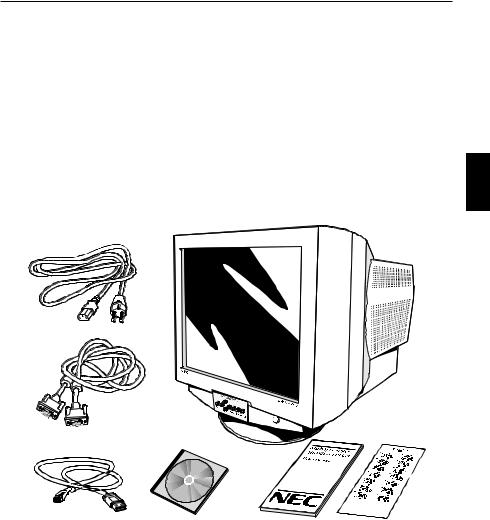
Lieferumfang
Im MultiSync FP Serie Karton* sollte folgendes enthalten sein:
•MultiSync FP Serie Farbmonitor mit Schwenk/Neigefuß MultiSync FP950 (JC-1946UMW) oder
MultiSync FP1350 (JC-2241UMW)
•Netzkabel
•Signalkabel
•USB Kabel
•Monitor Steuerungs Software
•Bedienerhandbuch
•Liste der Niederlassungen
Netzkabel
Signalkabel
USB Kabel |
Monitor |
|
Liste der |
|
Steuerungs |
Bedienerhandbuch |
Niederlassungen |
|
Software |
||
|
|
|
*Bewahren Sie die Originalverpackung für einen möglichen Transport oder Versand des Gerätes unbedingt auf.
Röntgenstrahlung
Die in diesem Gerät erzeugten Röntgenstrahlen sind durch die eigensichere Kathodenstrahlröhre ausreichend abgeschirmt.
Unsachgemäße Eingriffe, insbesondere Verändern der Hochspannung oder Einbau eines anderen Bildröhrentyps, können dazu führen, daß Röntgenstrahlung in erheblicher Stärke auftritt. So veränderte Geräte entsprechen nicht mehr dieser Zulassung und dürfen nicht betrieben werden.
D - 1
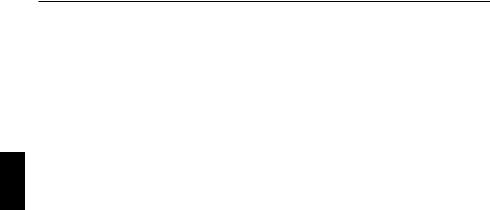
Inbetriebnahme
Beim Anschluß eines Monitors an Ihren Computer sind folgende Punkte zu beachten:
1.Schalten Sie die Stromversorgung von Computer und Monitor aus. Wenn Sie das Signalkabel verwenden, fahren Sie bitte bei Schritt 2 fort. Wenn Sie ein BNC-Kabel verwenden, gehen Sie bitte zu Schritt 3.
Achtung: BNC-Kabel können beim lokalen Händler bezogen werden.
2.Für den PC: Verbinden Sie ein Ende des 15-pin mini D-SUB Signalkabels mit der entsprechenden Buchse der Grafikkarte Ihres Rechners (Abbildung A.1) und das andere Ende mit der entsprechenden Buchse an der Monitorrückseite (Abbildung A.2). Ziehen Sie alle Schrauben fest. Gehen Sie zu Schritt 4.
Für den Macintosh: Stecken Sie den Macintosh Signaladapter (Option) auf die entsprechende Buchse der Grafikkarte des Macintosh (Abbildung B.1). Stecken Sie ein Ende des 15-pin mini D-SUB Signalkabels auf den Adapter (Option) am Rechner (Abbildung B.1) und das andere Ende mit der entsprechenden Buchse an der Monitorrückseite (Abbildung B.2). Ziehen Sie alle Schrauben fest. Gehen Sie zu Schritt 4.
3.Schließen Sie die BNC Stecker entsprechend der Kennung Rot Grün Blau an die gleichen Buchsen am Monitor an. Hat Ihr BNC Kabel nur vier Anschlüsse, so wird das Composite SYNC-Kabel an den Anschluß HS/CS des Monitors angeschlossen. Ist ein fünfter Stecker am Kabel vorhanden, so schließen Sie es am Anschluß VS am Monitor an. (Abbildung C.1)
Achtung: Falsch angeschlossene Signalkabel können zu einer Fehlfunktion oder zu einem Defekt führen.
D - 2
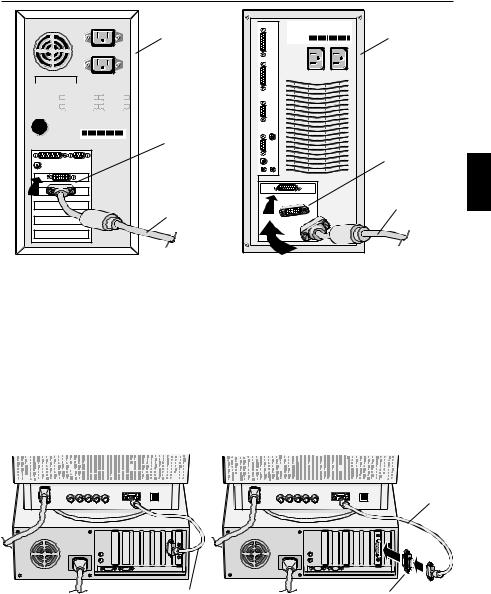
Computer |
Computer |
|
15-pin mini |
Macintosh Si- |
|
D-SUB |
||
gnaladapter |
||
|
||
|
(Option) |
|
Signalkabel |
Signalkabel |
|
|
||
Abbildung A.1 |
Abbildung B.1 |
4.Verbinden Sie das mitgelieferte Netzkabel auf einer Seite mit dem Monitor und auf der anderen Seite mit einer geerdeten Wandsteckdose in der Nähe des Monitors (Abbildung D.1).
5.Schalten Sie Monitor (Abbildung E.1) und Computer ein.
6.Die Werkseinstellung bei Ihrem Monitor sieht die Verwndung des mitgelieferten Signalkabels vor. Wenn Sie ein BNC-Kabel einsetzen wollen, drücken Sie den BNC/D-SUB-Knopf vorne (Abbildung E.1).
Hinweis: Sollten sich hierbei Probleme ergeben, so lesen Sie bitte den Abschnitt ,,Hilfe bei Problemen“
Signal-
kabel
|
Signalkabel |
Macintosh |
|
Signaladapter (Option) |
|
|
|
|
Abbildung A.2 |
|
Abbildung B.2 |
D - 3
